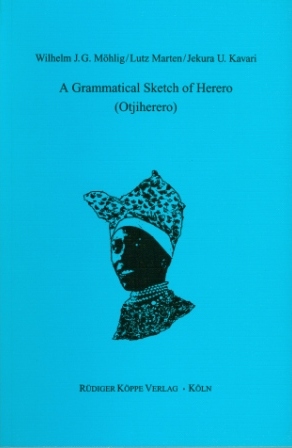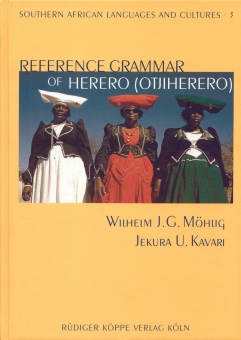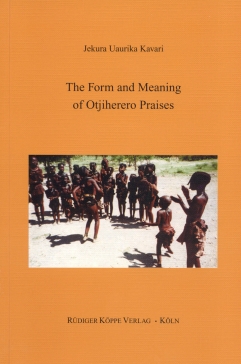


A Grammatical Sketch of Herero (Otjiherero)
Author: Wilhelm J.G. Möhlig †, Lutz Marten, Jekura Uaurika Kavari. Series edited by: Wilhelm J.G. Möhlig †, Bernd Heine.
Series: GA Grammatical Analyses of African Languages Volume 19
2002127 pp.
1 map, numerous tables, vocabulary English–Herero, Herero–English
Text language(s): English
Format: 160 x 240 mm
280 g
Paperback
€ 29.80
Buy 'A Grammatical Sketch of Herero (Otjiherero)' as a downloadable PDF document directly from our online shop »
Order 'A Grammatical Sketch of Herero (Otjiherero)' as print edition »
Herero / Otjiherero is a Bantu language (G.31) that is spoken mainly in Namibia and parts of Botswana and Angola. The present grammatical sketch of Herero (Otjiherero) contains a concise but complete grammar of the Herero language of Namibia.
All aspects of language structure are covered, in particular phonology, tonology, morphology, syntax and lexicon. Two elaborate text examples are included. Because of the limited size tables and paradigms prevail. An index allows quick access to topics beyond the traditional structure of a grammar. The intention of the book is two-fold. It offers a reliable aid for those interested in gaining a practical language proficiency in Herero, while for Herero native speakers it provides a good access to the English language.
The study is the result of a collaborative research designed as a European-African partnership project by three bantuists where one of them, Jekura U. Kavari, is a native speaker of Herero.
Under these links you will find further descriptions and text collections of the Herero language and culture, as well as of neighbouring south-west African languages and cultures:
Accompanying material:
- “When War came the Cattle slept”
(ISBN 978-3-89645-049-4 ) - Bridging the Language Gap
(ISBN 978-3-89645-890-2 ) - Namibian Languages
(ISBN 978-3-89645-080-7 ) - People, Cattle and Land
(ISBN 978-3-89645-363-1 ) - Reference Grammar of Herero (Otjiherero)
(ISBN 978-3-89645-602-1 ) - The Form and Meaning of Otjiherero Praises
(ISBN 978-3-89645-269-6 )
Cross-reference:
- A Grammatical Sketch of Rugciriku (Rumanyo)
(ISBN 978-3-89645-542-0 ) - A Learner’s Chichewa and English Dictionary (N.30)
(ISBN 978-3-927620-10-0 ) - A Tonal Grammar of Kwanyama
(ISBN 978-3-89645-084-5 ) - Animal Husbands, Magic Horns and Water Spirits
(ISBN 978-3-89645-221-4 ) - Bridging the Unbridgeable
(ISBN 978-3-89645-275-7 ) - Die Landfrage in Simbabwe
(ISBN 978-3-89645-621-2 ) - Konzeptualisierung von Landschaft
im Mbukushu (K.333/K.43) Bantusprache in Nord-Namibia)
(ISBN 978-3-89645-600-7 ) - Lucazi Grammar
(ISBN 978-3-89645-038-8 ) - Narrations of the Kavango
(ISBN 978-3-89645-279-5 ) - The Mbukushu in Angola
(ISBN 978-3-89645-350-1 ) - Trommeln in der Kirche
(ISBN 978-3-89645-917-6 )
Reviews
Riikka Halme in Journal of African Languages and Linguistics, 29/1, 2008, 118-121
| « back | Print version | [top] |
 Books
Books Audio
Audio Biographies
Biographies Series
Series Festschrifts
Festschrifts Journals
Journals